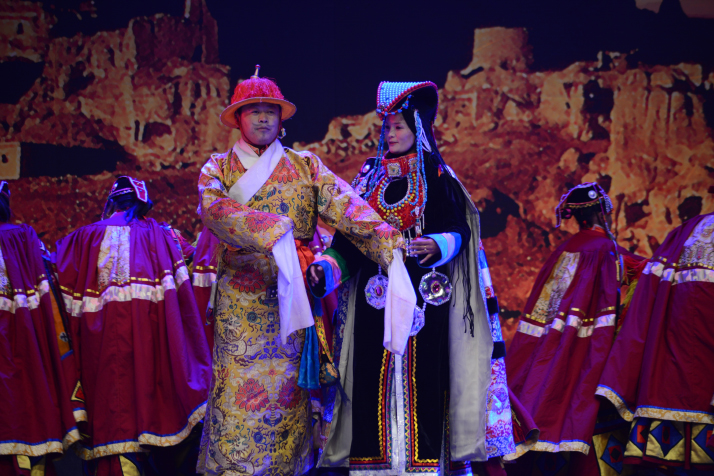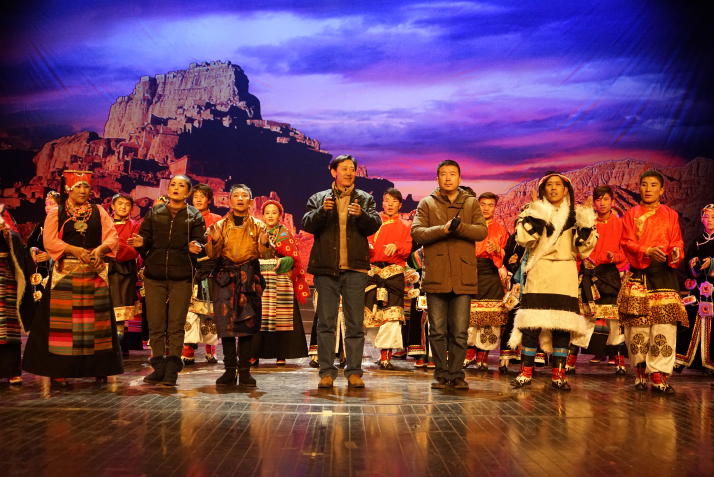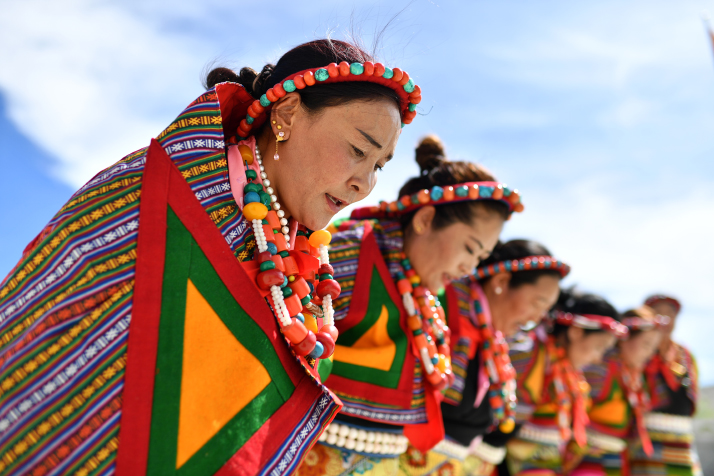| China |
| An educator's work to protect traditional Tibetan culture forges harmonious links | |
|
|
|
|
|
On a cold winter night five years ago, Yu Jiang became a tree of Tibetan hadas. He was surrounded by the troupe of actors he had been working with and they draped dozens of the ceremonial scarfs around his neck as a token of their gratitude and blessing. "All the actors brought hadas for me, and there were tears in their eyes. It was like a dream, a very, very nice one," Yu, now Deputy Curator of Ngari Museum in Tibet Autonomous Region, told Beijing Review. It happened two days after a performance in Xi'an, Shaanxi Province on January 29, 2016 and remains one of the warmest moments in the 54-year-old's life. Initially, Yu was a teacher and researcher in Shijiazhuang, capital of Hebei Province in north China, far from Tibet. He was also a part-time scriptwriter. Back then, he had no inkling that he would eventually script and produce The Saga of Ngari, the first historical drama on the rise and fall of Ngari Prefecture in Tibet, 1,520 km northwest of regional capital Lhasa, and with an average altitude of 4,500 meters above sea level. Now his involvement with Ngari and its culture has crossed three decades.  A scene from The Saga of Ngari, a historical drama on the rise and fall of Ngari Prefecture in Tibet Autonomous Region (YU JIANG)
A magic vista When he was a college student in 1986, Yu saw several photographs of the ancient Guge Kingdom in a magazine. The Himalayan kingdom existed from around the 10th to the 17th century in what is today's Ngari. "They were enthralling!" he said. "I wished that one day I could visit that area." In 1994, the Central Government rolled out a policy to provide greater support for Tibet. Some of the developed provinces were asked to help specific cities and counties in Tibet under a partnership assistance program. Hebei joined the program and was paired with two counties in Ngari. Many officials, teachers, doctors and technicians from Hebei volunteered to work in Ngari. Yu made his first trip to Lhasa in 2005, one year before trains on the Qinghai-Tibet Railway started to run from Xining in Qinghai Province to Lhasa. But when he wanted to go to Ngari, he was told the way was complicated and without a local guide, the prefecture was difficult to reach. "I had to give up my plan," Yu said. In 2013, one of his friends, who was volunteering in Ngari, invited him over for a visit. So Yu finally went to Ngari and explored many ancient temple ruins. At one, he saw newly unearthed Buddhist scriptures dating back to the 10th century, was fascinated and volunteered to take part in their preservation. But the Ngari Cultural Affair Bureau declined his offer because only professional organizations were asked to help in the excavation and preservation of relics. However, the bureau's chief Li Xingguo, touched by his love for Ngari, asked him to help produce a new drama for the Shangshung Cultural and Tourism Festival, held once every two years. Yu happily accepted the task. He delved into Ngari's past and wrote a script based on its major cultural integrations in different periods. "Ngari lies at the intersection of South, East and Central Asia. Its diversified culture proves it has long been a meeting point for different cultures," he said. He went back to Ngari in July 2015 for the rehearsals and ran into several hurdles. "I knew no Tibetan language and had to start the preparation from scratch. The biggest difficulty was gaining the trust of the local people," he said. One day, when he was walking in the street, a man accosted him, saying he was the mayor of Zanda, the county where the show was going to be staged. "What are you doing here?" the man asked, "You people don't understand Ngari culture." It was a huge blow to Yu's confidence. In addition, there was no professional actor or even a stage. And Yu had just three weeks before the premiere. Though three teams of directors went to the county, some were not used to the high altitude and left after a few days. Once, for one week, there was no director, and Yu was the only one overseeing the rehearsals. He filmed the performances and played them back for the actors and actresses to watch and improve their performance. The performers were local farmers and herders who had no stage experience. "They tried hard to act but just couldn't do it well," Yu said. So he stopped the rehearsal for one day, sat with the actors in a circle on the floor and told them the history of Ngari, from prehistory to present times. The next day, he noticed a remarkable improvement. "When they got into their costumes, they became the characters they were playing," Yu said. For the show, a stage was to be built near the Guge Kingdom ruins and there was a proposal to use cement, sand and steel. But Yu immediately rejected the plan because the ruins are a state-level cultural relic site and no unauthorized structures are allowed in their vicinity. He suggested building a stage using only soil and mud, which is more environmentally friendly and three days before the performance, the earthen stage was complete. "It remains functional even today. Every time I visit the site, the first thing I do is to check out my earthen stage," Yu said. The show was a success. When the music started and the performance reached the climax, the audience interacted enthusiastically. After the show, the county mayor who had earlier doubted him came and shook Yu's hand, thanking him. "From distrust to trust, the locals gave me the greatest support," Yu said.  Yu Jiang (front center) and the cast of The Saga of Ngari take a curtain call after a performance in Shijiazhuang, Hebei Province, on January 15, 2016 (YANG ZHANGQIAN)
Beyond the show Yu's original intention in creating The Saga of Ngari was to revive the Xuan, a traditional folk dance in which the dancers link hands and move in circles while singing. Xuan was recognized as an intangible cultural heritage in 2008 by the Central Government. Before 2015, there was only one maestro of the dance in the village of Toling in Ngari, who was teaching it to seven disciples. But by the time the drama premiered, all the 70 performers had mastered it. There were other unexpected results too. Two of the actresses were recruited by the county's folk art troupe. Phurbu Lhamo, 30 years old, was one of them. She used to be a herder struggling for survival under the poverty line, but after becoming a dancer in the troupe in 2015, she has a stable monthly income and has shaken off poverty. After the premiere, Hebei and Shaanxi, the two provinces that have helped with Ngari's development for decades, invited the troupe to perform in their cities. Most of the actors and actresses had never set foot outside Ngari and the trips outside Tibet changed their mindsets. "They are making greater efforts to improve their lives," Yu said. For Yangjen, a single mother with two children, the show was life-changing. Before performing in The Saga of Ngari, she had never been to Lhasa. She traveled to Shijiazhuang for the first time with the troupe and took the opportunity to buy some clothes at a wholesale market there. She sold them in Ngari and made some money. The second time she went to Shijiazhuang, she carried over 30,000 yuan ($4,661) to buy more clothes. A month later, she called Yu, saying she wanted to return to Shijiazhuang a third time as all the clothes had been sold out. Yu introduced a Shijiazhuang-based wholesaler to Yangjen, who sent photographs of the new collections to her via WeChat and delivered her orders to Tibet. This is the mode of operation now, so she can run the business without having to take frequent trips to Shijiazhuang. In addition to benefiting individuals, troupe members hope the drama will boost Ngari's development. Thubten, a 47-year-old member of the troupe, hopes that more people would come to know about Ngari after watching it. "The more people know about Ngari, the more tourists and business people will come and Ngari will grow faster," he told Beijing Review.  Yangjen (first left) and others do Xuan, a traditional folk dance, in the village of Toling, Ngari, Tibet. Xuan was recognized as an intangible cultural heritage in 2008 (XINHUA)
Emotional treasures After the drama was staged in Hebei and Shaanxi in January 2016, Yu returned to Shijiazhuang but the troupe members stayed in touch, calling him up regularly. Yu said proudly that he has Tibetan relatives in almost every village in that county in Ngari. "We care about each other. The emotional tie is a precious treasure in my life," he said. It brought him back to Ngari again. In the summer of 2016, his wife and he signed up to assist in Tibet's development for three years. When their tenure was over, the couple applied to work in Tibet for the rest of their lives, and he became deputy curator of Ngari Museum. This is now Yu's seventh year in Tibet. He has been to over 40 towns in Ngari, where he conducted field research, directed the Shangshung Cultural and Tourism Festival, and built a museum themed on the peaceful liberation of Ngari. He has also had the Ngari Library upgraded, adding a special room with controlled temperature and humidity to preserve ancient books and scriptures, getting closer to the realization of his first dream. He hopes more specialized professionals get to know about Ngari and come to work to preserve its ancient scriptures. However, he has had to pay a price for his passion. The plateau's high altitude, lack of oxygen and low atmospheric pressure have affected his health. "I lost four teeth over the past four years because the low oxygen in Tibet can affect one's peripheral nerves and blood supply," he said. His lungs have enlarged and there are other ailments related to highland living. But he feels the price worthwhile as he has witnessed the social development in Tibet. "I am not a member of the Communist Party of China (CPC), but I have been an eye witness to their work in Tibet," Yu said. When he first arrived in Shiquanhe, the administrative seat of Ngari, it did not even have a good highway. Now it has become a modern city. "The Central Government provides funding every year to improve people's life and promote the development of the region, leaving no one behind," he said. With their life getting better, more Tibetans have the chance to travel out of the region. Troupe members visited Beijing on January 12, 2016 after a show in Shijiazhuang. After arriving at Tiananmen Square, where the national flag is flown, they were so thrilled that they spontaneously linked hands and performed a traditional dance in a circle, to the delight of other visitors. "As onlookers took pictures of them dancing, I felt proud," Yu said. "It was the epitome of unification and ethnic harmony." BR (Print Edition Title: A Life of Drama) Copyedited by Sudeshna Sarkar Comments to linan@bjreview.com |
|
||||||||||||||||||||||||||||
|